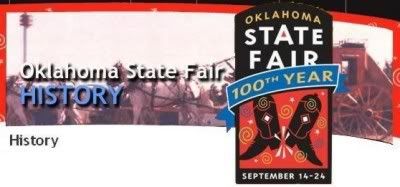
The inaugural Oklahoma State Fair opened its doors at N.E. 10th and Eastern (now Martin Luther King Jr.) in October 1907 in the facilities which are portrayed in this post. Before the fair's opening in Oklahoma City, it was no means a sure thing that it would do so, and, or course, it would not remain at it's initial location. This post traces the origins and shows some images of those early days of the Oklahoma State Fair, now long gone by.
ORIGINS
Oklahoma City was not the only contender to host the State Fair of Oklahoma. Particularly, the city of Muskogee, with its much richer history as being the center of events in the Indian Territory, presented itself as a viable contender. In the October 2, 1906, Daily Oklahoman, the text reads, "Muskogee, I.T., Oct. 1 – The New State fair opened here ths morning under the most favorable circumstances and with an attendance beyond expectations. This fair is laid out on a plan that contemplates making it a state institution, with state support. It is the first time where many towns have joined together to make one big fair. Twenty towns had exhibits on the ground." On October 9, 1906, the Daily Oklahoman reported,
The success of the new state fair which closed Sunday was such that before the next day's session was over a meeting of the backers of the first air was held and that a permanent organization was formed and it has already decided that there will be a fair next year. The fair which has just closed was the result of public spirt and public enterprise. The business men of the city got together and put up the money to make the fair a success. They took their chances on ever getting it back, in fact they regarded it as a donation. * * * An effort is likely to be made to get state recognition."Business men in Oklahoma City were not quite ready to take a back seat to Muskogee.
From what I've read, almost certainly the most prominent of those was Charles Graham Jones, our 7th (4/13/1896 - 4/12/1897) and 10th (4/8/1901 - 4/13/1903) mayor, businessman and railroad promoter. In the January 6, 1907, edition of the Daily Oklahoman, the bold headline reads, "Jones Favors State Fair". The article reads,
"The establishment of a great state fair in Oklahoma is imperative and now is the opportune time," said C. G. Jones yesterday when asked as to the outlook for such an institution.Jones was not unmindful of the fancies of other-than-agrarian interests, though. The article continues, quoting Jones:
"A state fair is not a local affair, but is of interest to all people of the state. Oklahoma City is the logical selection on account of the location and the admirable railroad facilities to enable the patrons to reach the fair."
Asked if he would become a stockholder in an association if such were organized, Mr. Jones replied:
"Yes, I will take considerable stock if the business men of this city will get behind the proposition and push it to completion, for a fair is of vital importance, not only to the business interests but in a larger way to the agriculturists, horticulturists and stock raisers of the new state. The foundation of a state fair is built by the men from outside the cities; they are the ones who bring the exhibits of farm products, the fancy cattle, the light harness horses, the draft horses of great size and power, the poultry and the splendid displays of grin and fruit."
"And while [horse] races are a feature, and a necessity, they are for the purpose of furnishing excitement, but do not compare in the importance with the other features. It will be necessary to have a mile track in connection with the fair. A half mile track, while smaller, and bringing the horses before the spectators oftener, will not attack the horses of high class and of extreme speed. And to have a big fair, which is the only kind that we shall at any time consider, we must have the large track, so that horse owners from all over America will bring their two minute performers to Oklahoma to compete for the rich prizes will be hung up.Other Oklahoma City business men were open to the challenge. In a January 8, 1907, article in the Daily Oklahoman Frank H. Shelly was said to have joined the chorus. In the article, he was quoted as saying, "The business men of our city should organize a state fair association before this month has expired." The article seems to present a sense of urgency – purchase ground, erect buildings, build a mile horse race track. Shelly advocated not waiting for the legislature's action and asking appropriations. His rationale was said to be this:
"I believe that we should start a fair and not try to have any dividends. State fairs are not established for money making purposes, but for patriotic ones, and the earnings of the fair should be invested in permanent buildings, so that in a few years, the first lot of frame buildings would be replaced with structures of iron, for Oklahoma should have a permanent grounds equipped eventually like those of Springfield, Ill., and Dallas, Texas."
"A state fair in this city would bring for a week the greatest crowds that have ever been in Oklahoma City. Dallas drew as high as 80,000 people on some of the days of the fair held last fall, and it is the best attraction that money can bring. * * *Oklahoma City fair committee members would shortly visit Dallas according to a February 26, 1907, Daily Okahoman article which reports the Oklahoma City's committee' intention to model Oklahoma City's "State Fair" after the Dallas model. The article also notes, however, that the committee would endeavor, and presumably need, to raise $75,000 in local commitments before it would proceed beyond the theoretical.
However, we must act quickly if we act all. If we delay, it will not be possible to have a creditable fair. And Oklahoma city does not do things that are not creditable."
All locals were not as enthusiastic. A headline in the March 22, 1907, Daily Oklahoman reads, "Will Oklahoma City Let The Fair Go?" From the article:
It is asserted that pushers of the fair proposition are growing lukewarm over the inability to interest the citizens of Oklahoma City. It is only a question of days until the matter will be settled for good. * * * Muskogee is ready to grab the fair at the first chance and Oklahoma City will have to subscribe $10,000 before Saturday afternoon or lose.Five days later, a March 27, 1907, Daily Oklahoman article's headline reads, "Cold Water Thrown On The State Fair," says it all. The article says,
The apathy with which certain interests in Oklahoma City receive the sate fair proposition is declared to be a stumbling block in the success of the enterprise.Even so and somehow, it all got done. As this article is written, the 1st State Fair in Oklahoma City in October 1907, is now enjoying it's 100th consecutive manifestation in State Fair Park.
Yesterday the committee on stock subscriptions approached a prominent jobber in the city and asked him his views of the state fair. He replied that he could not see any material benefit that would occur to the jobbers and therefore he would not help support the scheme by subscribing to the necessary fund.
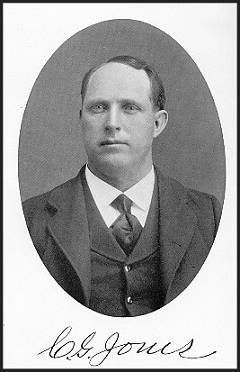 I've not found anything calling Charles G. Jones the "founder", "benefactor", or other title of the Oklahoma State Fair in Oklahoma City. Yet, from what I've read in the Daily Oklahoman, it is safe to say that, today, when you're eating your corn dogs and/or going vertical on the space needle, it would do you no harm to say, "Thanks, C.G. Jones," or, as was pointed out by Dustbury's C.G. Hill, you could say, "Thanks, Grist Mill, to you and your associates, for making this fine day in State Fair Park, possible. Otherwise, I might just have to travel to Muskogee for the experience!"
I've not found anything calling Charles G. Jones the "founder", "benefactor", or other title of the Oklahoma State Fair in Oklahoma City. Yet, from what I've read in the Daily Oklahoman, it is safe to say that, today, when you're eating your corn dogs and/or going vertical on the space needle, it would do you no harm to say, "Thanks, C.G. Jones," or, as was pointed out by Dustbury's C.G. Hill, you could say, "Thanks, Grist Mill, to you and your associates, for making this fine day in State Fair Park, possible. Otherwise, I might just have to travel to Muskogee for the experience!"As an aside, see this fascinating OHS article for a "Grist Mill" reference to Mr. Jones in another context which I'll get to eventually - how Oklahoma City became the state's capital city.
IMAGES OF THE STATE FAIR OF OKLAHOMA
These are the best that I've found of early day postcards and photos. Click on a pic for a larger image.
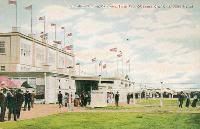
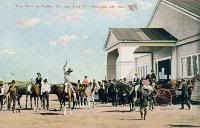
About the above-right pic (Roping Contest), text from Vanished Splendor, at it's item 174 is worth mentioning: "The famous 101 Ranch from Bliss, Oklahoma, sent a contingent of cowboys to at least one of the State Fairs and card no. 174 shows one of their finest, Bill Pickett. Bill was a black cowboy from south Texas who is said to have originated the idea of bulldogging in a 'bite-'em-lip" fashion. Bill was skilled with his rope, as he demonstrated here."


Credit Ok County Assessor's Website – Exposition Building and Entrance


Credit Vanished Splendor, Vol 2, Edwards & Ottaway (Abalache Book Shop Publishing Co. 1983) and Ok County Assessor's Website – Entrance
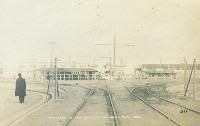
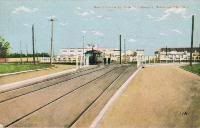
Credit Ok County Assessor's Website – Aerials
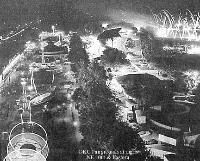
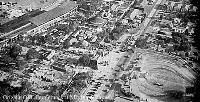
Credit Vanished Splendor, Vols 1 and 2, Edwards & Ottaway (Abalache Book Shop Publishing Co. 1982, 1983) – Racetrack
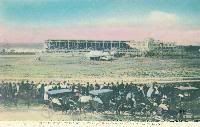
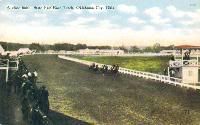
Credit Vanished Splendor, Vol 1, Edwards & Ottaway (Abalache Book Shop Publishing Co. 1982) – Racetrack

Go To Top














3 comments:
Dustbury's CG Hill adds some nice history here. In that post's Comments, a nephew of Henry Overholser notes that Henry was the father of the Oklahoma State Fair, something my limited research did not disclose.
I can remember attending the Oklahoma State Fair when it was located on North Eastern. I may have been 4 or 5 years old, and I think I attended more than one year. It had a recessed area on Eastern Street where the city busses pulled in and unloaded/loaded. Almost everyone rode the bus to the fair. It was a much smaller fair than the one later built across town. I remember riding the Farris Wheel, and I think I remember it being called The Big Dipper. I also remember tasting my first cotton candy there (it was pink), and my first time to see and ride on a beautiful carousel pony was at that fair.
Post a Comment